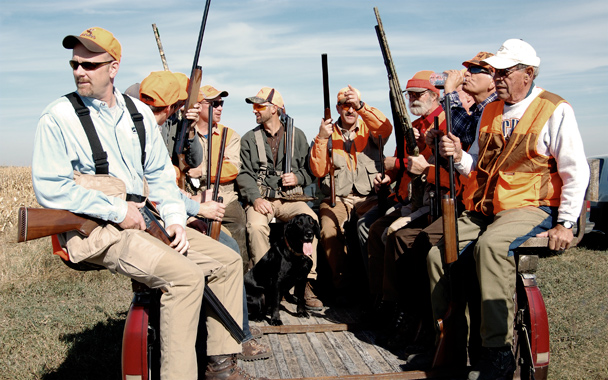The very first thing that Rollin Christenson wanted to talk about when I first met him in June was the October harvest. His eyes lit up with excitement. He had long since turned the farm over to his sons, and liked spending the coldest part of the South Dakota winter in Texas. But the corn harvest—that was his annual moment of glory. Life has purpose during the harvest that reaches back through decades of accumulated memories. He and his sons work as a team. Everyone had a precise role. Rollin’s job would be to drive the grain cart. But last Tuesday night, when I listened to the message on my cell phone, Scott Christenson’s voice was tired and frustrated. “This has been just a terrible harvest,” he said. “It’s been wet for two weeks. We can’t get anything done. And Dad broke his hip falling off the tractor.”
“So does that knock him out of the harvest?” I ask when I finally reach Scott. “No, he’s too stubborn. We just put him in the front end loader and hoist him into the tractor. He drives all day long.” All day, that is, when it’s not too muddy to work.
All four of our farmers should be harvesting corn by now. Instead, they still have soybeans in the field, and the weather is going from bad to worse. There’s more rain in the forecast, and snow. “We’ve got soybeans sitting in water,” Scott reports. Charlie Johnson has already contacted his insurance agent about writing part of his soybean crop off as a weather disaster. “If I have to let the beans go, they’ll pay me $11 a bushel on my loss, but my contract [with an organic soy milk processor] is for $20 a bushel if I can get them combined.” Twenty dollars a bushel for Charlie’s organic soybeans is a whopping premium, more than 100 percent higher than the current market price for non-organic beans on the Chicago Board of Trade. But he has to be able to get the beans harvested, and with more weather bearing down on him, Charlie sits around the machine shop, frustrated. “The combine and tractor and cart are just sitting there, right by the barn door, waiting for good weather.”
As befits his personality, Dale Hargens is relentless. His campaign for the South Dakota State Senate is going full throttle. He spends most nights at campaign events. He’s behind on the soybean harvest. But early Saturday morning he decides to combine the edges of his corn fields, “just to get some real numbers” for the pending harvest. He is all smiles. “There’s at least 150 bushels an acre out there. But it’s still too wet.” Grain dealers, and ethanol plants, don’t like corn to be any wetter than 16 or 17 percent; Dale’s is over 20 percent. He stores his morning haul in a huge sausage-like, expandable plastic tube for use on the farm as cattle feed this winter, then climbs out of his tractor, puts all his anxieties aside for the day, and engages in the great, iconic cultural event of the South Dakota harvest season: the opening of pheasant season.
Down the road, Jim Lutter is trying to squeeze a little cash profit out of opening day. Like hundreds of South Dakota farmers, Jim charges a fee for out-of-state hunters to stay in his small lodge, enjoy the luxury of home-cooked meals for a few days, and hunt his land. Over the course of the last decade, pheasant hunting has grown into an economic boon for South Dakota farmers. Last year alone 180,000 hunters (100,000 from out of state) shot over two million pheasants and poured almost $220 million into South Dakota’s tourism and farm economy.
Dale’s approach is more traditional. The opening-day hunt is for family and friends only. His older brother drives in from Custer, his sister’s family arrives from Rapid City, extended family from Washington state, friends from Huron and Sioux Falls. Twenty-five hunters are gathered in the front yard of the farm house, decked out in flaming, day-glow orange. Everyone is impatient. This is a moment they anticipate for a whole year, their chance to reconnect with the family farm. Dale is matter-of-fact, almost indifferent. Maybe he’s thinking about the soybeans sitting in the field. He doesn’t even bother to dress the part of the hunter, just grabs his shotgun and takes the lead.
The corn is eight feet high, almost impossible to walk through, treacherous to shoot in. The birds run ahead, fake flight, sprint between the rows, double back behind the hurried hunters. Some birds are pushed to the ends of the fields where they finally take to the air and meet a thunderous wave of shot. All day long the family moves from field to field, repeating the hunt, and at day’s end 60 birds are piled in the back of a pickup truck. With the sun sinking, they are gutted, cleaned, and taken to the home of Dale’s mother, where a feast is prepared. In the dark, I lose track of Dale. Everyone is exhausted. Dale is nowhere to be found. “Where is he?” I ask his daughter and business partner, Andrea. “He went out to combine soybeans.” “But it’s dark.” “Yeah, the combine has lights.”
On Wednesday the first snow of the season blankets eastern South Dakota. It melts in a few hours but portends a hard week ahead. “These are the worst kind of days.” Charlie Johnson remarks from his kitchen table. “I can’t even go outside and do chores.”




 Pinterest
Pinterest


